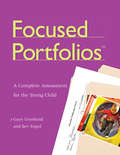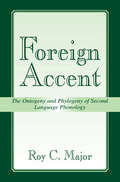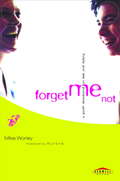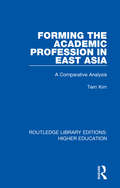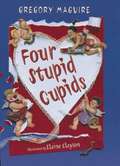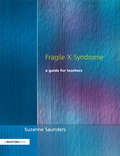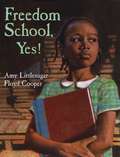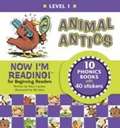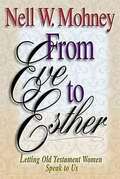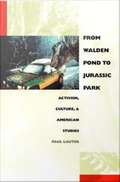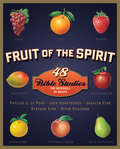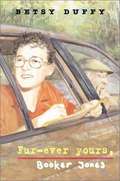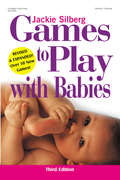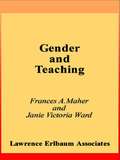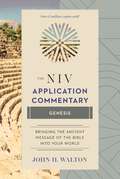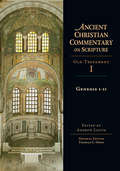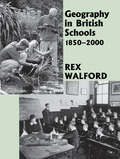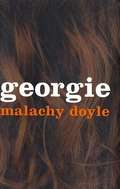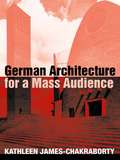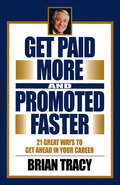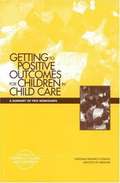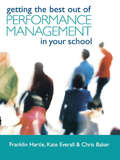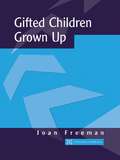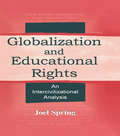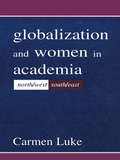- Table View
- List View
Focused Portfolios(tm): A Complete Assessment for the Young Child
by Gaye Gronlund Bev EngelOffers an innovative method to accurately document children's growth and development by observing them in the midst of their everyday activities. Used for years in programs across the country, this easy-to-use system helps teachers assess children's progress in four areas (Favorites, Friends, Family, and Developmental Milestones). Eight chapters include a complete introduction to the Focused Portfolios method, many step-by-step examples, and all the necessary forms for portfolio collection.
Foreign Accent: The Ontogeny and Phylogeny of Second Language Phonology (Second Language Acquisition Research Series)
by Roy C. MajorEven though second-language learners may master the grammar and vocabulary of the new languages, they almost never achieve a native phonology (accent). Scholars and professionals dealing with second-language learners would agree that this is one of the most persistent challenges they face. Now, for the first time, Roy Major's Foreign Accent covers the exploding scholarship in this area and lays out the issues specifically for audiences in the second language acquisition and applied linguistics community.
Forget Me Not
by Mike WorleyExtreme Wisdom for Some of Life's Most Extraordinary RelationshipsIf you've ever had a crush on someone, or if you've ever gone on a date, you know that the guy-girl relationship is one of the most exciting, complicated, and distracting relationships there are in life. When you've got your eye on someone special, it's easy to lose sight of other things that really matter to you-friends, family, schoolwork, goals and dreams... even God. But God doesn't want to be kept on the outside. He cares about you and your relationships. In this 31-day devotional--complete with stories about teens like you, questions to make you think, key Scriptures, and room to journal--you'll learn how to make God an important part of your dating experiences and keep him first place in your life, no matter who turns your head or captures your heart.
Forming the Academic Profession in East Asia: A Comparative Analysis (Routledge Library Editions: Higher Education #14)
by Terri KimOriginally published in 2001, Forming the Academic Profession in East Asia, examines the changing shape of the academic profession in South Korea, Malaysia and Singapore since the colonial period, and as a reflection of both the inherited models of higher education and their redefinition after the colonial period. The analysis takes into account the connections and disconnections between the colonial and postcolonial periods in shaping the academic profession.
Four Stupid Cupids (Hamlet Chronicles #4)
by Gregory MaguireThe students' scheme to find a love match for their beloved teacher on Valentine's Day turns into a comedy of errors when four stupid cupids from Ancient Greece try to help.
Fragile X Syndrome: A Guide for Teachers
by Suzanne SaundersFragile X Syndrome is thought to be the most common inherited cause of learning difficulties. However many people have never heard of it and those who have, including many of the professionals who work with those affected by it, have little knowledge or understanding of the condition. This book brings up to date research with information and advice from teachers who are discovering, first hand, the best ways of educating children with Fragile X. It is much needed support and advice that will help teachers to understand the child with Fragile X and encourage maximum educational progress. / While the book is aimed at teachers, it is also an excellent resource for parents, therapists and any professional working with a child who has Fragile X.
Freedom School, Yes!
by Amy LittlesugarWhen their house is attacked because her mother volunteered to take in the young white woman who has come to teach black children at the Freedom School, Jolie is afraid, but she overcomes her fear after learning the value of education.
Frog Cops (Animal Antics Level One, Book #7)
by Nora GaydosLEARN TO READ WHILE HAVING FUN! Zany illustrations, funny animal stories, and teacher-approved learning methods come together in this collection of 10 story booklets for young readers to enjoy. Meet a cub covered in mud, a pig doing a jig, a fish with a gift, and more in this collection of humorous stories and zany illustrations! Each of the stories in this Now I'm Reading! Level 1 reader focuses on one specific short-vowel sound and uses simple, clear text and a building-block approach to help beginning readers have fun while learning key words. Includes 10 story booklets, 40 incentive stickers, "After You Read" easy comprehension questions and "Skills in This Story" sections in each book, and a parent guide to help parents get the most out of each story booklet. Perfect for ages 4 and up! Level 1 NIR readers focus on short vowel sounds, simple consonant sounds, and beginning sight word introduction. The concepts and skill progression in the NIR series are aligned to meet Common Core State Standards. This book is Fountas & Pinnell Level B/C.
From Eve to Esther: Letting Old Testament Women Speak to Us
by Nell Webb MohneyIn the first of a two-book series on women of the Bible, Mohney presents eight stories on Old Testament women and the lessons they can impart today. The author combines research into the customs of the day with her own imagination to help today's women identify with their biblical counterparts.
From Walden Pond to Jurassic Park: Activism, Culture, & American Stduies
by Paul LauterPaul Lauter, an icon of American Studies who has been a primary agent in its transformation and its chief ambassador abroad, offers a wide-ranging collection of essays that demonstrate and reflect on this important and often highly politicized discipline. While American Studies was formerly seen as a wholly subsidiary academic program that loosely combined the study of American history, literature, and art, From Walden Pond to Jurassic Park reveals the evolution of an independent, highly interdisciplinary program with distinctive subjects, methods, and goals that are much different than the traditional academic departments that nurtured it. With anecdote peppered discussions ranging from specific literary texts and movies to the future of higher education and the efficacy of unions, From Walden Pond to Jurassic Park entertains even as it offers a twenty-first century account of how and why Americanists at home and abroad now do what they do. Drawing on his forty-five years of teaching and research as well as his experience as a political activist and a cultural radical, Lauter shows how a multifaceted increase in the United States' global dominion has infused a particular political urgency into American Studies. With its military and economic influence, its cultural and linguistic reach, the United States is--for better or for worse--too formidable and potent not to be understood clearly and critically.
Fruit of the Spirit: 48 Bible Studies for Individuals or Groups
by Peter Scazzero Jacalyn Eyre Jack Kuhatschek Phyllis J. Lepeau Stephen EyreThese forty-eight Bible studies were written with one goal in mind – to allow the Spirit of God to use the Word of God to produce fruit in your life. These studies will help you discover what the Bible says rather than simply telling you what it says. They encourage you to think and to explore rather than to merely fill in blanks. Fruit of the Spirit will help you discern what the Bible says about the vital traits that the Holy Spirit produces in believers, and move you beyond reflection to application. Designed for use as personal Bible study or group study, the interactive format will help you grow in your ability to reflect the character of Jesus and will aid not only in understanding the fruit, but also in applying them to daily life.
Fur-ever Yours, Booker Jones
by Betsy DuffeyTwelve-year-old Booker Jones turns to his writing once again to deal with the stress of his parents' decision to vacation together, leaving family and laundry behind.
Games to Play with Babies
by Jackie SilbergOver 240 fun-filled games include lots of hugs and kisses to help babies bond with their caregivers and parents as they develop necessary skills. Babies experience the interaction and nurturing they need for healthy self-esteem. This book encourages the development of happy, trusting babies who will become happy, trusting toddlers. If there's a baby in your child care center or in your family, you won't want to miss these wonderful games.
Gender and Teaching
by Frances A. Maher Janie Victoria WardGender and Teaching provides a vivid, focused, and interactive overview of the important gender issues in education today. This is accomplished through conversations among experts, practitioners, and readers that are informed by representative case studies and by a range of theoretical approaches to the issues. Gender and Teaching is the third volume in the "Reflective Teaching and the Social Conditions of Schooling" series edited by Daniel P. Liston and Kenneth M. Zeichner. It follows the same format as previous volumes in the series. Part I includes four cases dealing with related aspects of gendered experiences in schools (nonsexist elementary school curricula, gender and race implications of special education assignment practices, homophobia in high schools and classrooms, and teaching as a woman's profession), followed by a set of teachers', administrators', and professors' reactions to each case. Part II is an elaboration of four "public arguments"--conservative, liberal, women-centered, and radical multicultural--pertaining to the issues raised in the cases in Part I. These arguments exemplify clusters of orientations, organized around general values rather than hard and fast principles. Part III presents the authors' own interpretations of the issues raised throughout the work and provides activities and topics for reflection and an annotated bibliography of additional resources. Content and Pedagogical Features: *Readers are encouraged throughout to interact with the text. They can respond to each case and compare their responses to those of others in the field. *The cases and discussions that follow help students begin to evolve their own "practical theories"; explore and perhaps modify some of their basic beliefs and assumptions; become acquainted with other points of view; and look further into the connections and intersections of gender with other structural dynamics and practices--those of race, class, and culture--as intrinsic to their explorations into the social conditions of schooling. *The major strands in feminist theory about women and education are presented so that students can analyze the differences among them, come up with positions of their own, and learn to defend them. *Although the authors draw on historical and sociological frameworks that show how women have historically been discriminated against in our schools and in our society, their goal is an education that is equally fair to everyone, boys as well as girls. Gender and Teaching is pertinent for all prospective and practicing teachers at any stage of their training. It can be used in any undergraduate or graduate course that addresses issues of gender and teaching.
Genesis (The NIV Application Commentary)
by John H. WaltonThe NIV Application Commentary helps you communicate and apply biblical text effectively in today's context.To bring the ancient messages of the Bible into today's world, each passage is treated in three sections:Original Meaning. Concise exegesis to help readers understand the original meaning of the biblical text in its historical, literary, and cultural context.Bridging Contexts. A bridge between the world of the Bible and the world of today, built by discerning what is timeless in the timely pages of the Bible.Contemporary Significance. This section identifies comparable situations to those faced in the Bible and explores relevant application of the biblical messages. The author alerts the readers of problems they may encounter when seeking to apply the passage and helps them think through the issues involved.This unique, award-winning commentary is the ideal resource for today's preachers, teachers, and serious students of the Bible, giving them the tools, ideas, and insights they need to communicate God's Word with the same powerful impact it had when it was first written.
Genesis 1-11 (Ancient Christian Commentary on Scripture #Old Testament Volume 1)
by Andrew LouthThe rich tapestry of the creation narrative in the early chapters of Genesis proved irresistible to the thoughtful, reflective minds of the church fathers. Within them they found the beginning threads from which to weave a theology of creation, fall and redemption. Following their mentor, the apostle Paul, they explored the profound significance of Adam as a type of Christ, the second Adam. The six days of creation proved especially attractive among the fathers as a subject for commentary, with Basil the Great and Ambrose producing well-known Hexaemerons. Similarly, Augustine devoted portions of five works to the first chapter of Genesis. As in previoWW volumes within the Ancient Christian Commentary on Scripture, the range of comment contained in Genesis 1--11 spans from the first century to the eighth, from East to West, and from Greek and Latin speakers to Syriac. Especially helpful in this volume is editor Andrew Louth's supply of Septuagintal alternative readings to the Masoretic text, which are often necessary to understanding the fathers' flow of thought. Genesis 1--11 opens up a treasure house of ancient wisdom--allowing these faithful witnesses, some appearing here in English translation for the first time, to speak with eloquence and intellectual acumen to the church today.
Geography in British Schools, 1885-2000: Making a World of Difference
by Rex WalfordThis history charts how geography rose to popularity on a tide of imperial enthusiasms in Victorian time and made its way into many elementary schools in the latter half of the 19th century. Many geography lessons were not dominated by the rote-learning of "capes and bays" and some of the pioneers of the subject led the way in the use of models, visual aids and "object lessons" in schools.The book explores Scott Keltie's report of 1886 as a catalyst for development. Despite the founding of the Geographical Association in 1893, the subject needed a series of concerted political campaigns in the early 20th centry to establish itself in the secondary sector. The growth of the regional approach, field-work and of sample studies expanded the subject between the world wars, before a major conceptual revolution invigorated and challenged teachers of the subject in the post-war period.
Georgie
by Malachy DoyleWith help from a sympathetic fellow resident, a patient teacher, and other staff at a school for emotionally disturbed teenagers, fourteen-year-old Georgie begins to find his way back to sanity.
German Architecture for a Mass Audience
by Kathleen James-ChakrabortyThis book vividly illustrates the ways in which buildings designed by many of Germany's most celebrated twentieth century architects were embedded in widely held beliefs about the power of architecture to influence society. German Architecture for a Mass Audience also demonstrates the way in which these modernist ideas have been challenged and transformed, most recently in the rebuilding of central Berlin.
Get Paid More and Promoted Faster: 21 Great Ways to Get Ahead in Your Career
by Brian TracyThe New York Times-bestselling author reveals how to make yourself more valuable, maximize your strengths, and become virtually indispensable. Get Paid More and Promoted Faster is not a book on office politics. It doesn&’t offer short cuts and work-arounds. It will help you develop the discipline and determination you need to get more done, earn the respect of co-workers and bosses, and move upward to greater and greater levels of success. It teaches the methods and behaviors that every manager wishes every employee to know. This book can serve not only as a guide to individual advancement but as the content of a career development plan for everyone in an organization. The easy-to-apply ideas and techniques in Get Paid More and Promoted Faster will help you move rapidly up the career ladder and achieve more than you ever thought possible. Not only will you make more money, but you will also experience greater personal satisfaction and fulfillment, and make your life and career into something truly extraordinary.
Getting To Positive Outcomes For Children In Child Care: A Summary Of Two Workshops
by Board On Children Families YouthA summary on Getting To Positive Outcomes For Children In Child Care
Getting the Best Out of Performance Management in Your School
by Chris Baker Kate Everall Franklin HartleTried-and-tested by specialist educational consultants Hay Management Consultants, this volume will help head teachers and subject leaders make the most out of performance management in their schools. The government's insistence that each school in England (whether primary or secondary) implements a performance management system has lead schools to see this imposition as yet another bureaucratic chore. This volume shows how performance management can be turned to a school's advantage to improve teaching and school performance. Highly practical in tone, the book shows how schools can turn a government imposition into an opportunity for realistic and tangible improvement.
Gifted Children Grown Up: What Happens When Gifted Children Grow Up
by Joan FreemanMore than a quarter of a century ago, Joan Freeman began this study of 210 children, comparing the recognized gifted, the unrecognized gifted and their classmates. This book: describes what happened to them and their families as they grew up and coped with their different circumstances. It also looks at the problems they faced, often described in their own words and contains personal details from in-depth interviews in homes and schools all over Britain, which are at times startling and sometimes depressing. It lays to rest many myths about the development of gifted children. The book offers insights into the special situations of the gifted and points out much needed changes in their care and education. It is not only important for their own fulfillment and happiness, but for the future of society.
Globalization and Educational Rights: An Intercivilizational Analysis (Sociocultural, Political, and Historical Studies in Education)
by Joel SpringThis is the first book to explore the meaning of equality and freedom of education in a global context and their relationship to the universal right to education. It also proposes evaluating school systems according to their achievement of equality and freedom. Education in the 21st century is widely viewed as a necessary condition for the promotion of human welfare, and thus identified as a basic human right. Educational rights are included in many national constitutions written since the global spread of human rights ideas after World War II. But as a global idea, the meaning of educational rights varies between civilizations. In this book, which builds on the concept of the universal right to education set forth in Spring's The Universal Right to Education: Justification, Definition, and Guidelines, his intercivilizational analysis of educational rights focuses on four of the world's major civilizations: Confucian, Islamic, Western, and Hindu. Spring begins by considering educational rights as part of the global flow of ideas and the global culture of schooling. He also considers the tension this generates within different civilizational traditions. Next, he proceeds to: *examine the meaning of educational rights in the Confucian tradition, in the recent history of China, and in the Chinese Constitution; *look at educational rights in the context of Islamic civilization and as presented in the constitutions of Islamic countries, including an analysis of the sharp contrast between the religious orientation of Islamic educational rights and those of China and the West; *explore the problems created by the Western natural rights tradition and the eventual acceptance of educational rights as represented in European constitutions, with a focus on the development and prominence given in the West to the relationship between schooling and equality of opportunity; and, *investigate the effect of global culture on India and the blend of Western and Hindu ideas in the Indian constitution, highlighting the obstacles to fulfillment of educational rights created by centuries of discrimination against women and lower castes. In his conclusion, Spring presents an educational rights statement based on his intercivilizational analysis and his examination of national constitutions. This statement is intended to serve as a model for the inclusion of educational rights in national constitutions.
Globalization and Women in Academia: North/west-south/east (Sociocultural, Political, and Historical Studies in Education)
by Carmen LukeIn this cross-cultural exploration of the comparative experiences of Asian and Western women in higher education management, leading feminist theorist Carmen Luke constructs a provocative framework that situates her own standpoint and experiences alongside those of Asian women she studied over a three-year period. She conveys some of the complexity of global sweeps and trends in education and feminist discourse as they intersect with local cultural variations but also dovetail into patterns of regional similarities. Western feminist research has established that relatively few women hold senior positions in universities and colleges. Using the now common metaphor of the "glass ceiling," this research has developed a range of social, cultural, and institutional explanations for women's underrepresentation in academic life. International studies show that women in non-Western countries are also underrepresented in higher education. Yet do Western explanations and strategies for change hold for academic women working in non-Western universities? The very diversity among women's experiences calls into question many of the analytic tools, terms, claims, and solutions formulated by Western feminism. This is the first study to show how cultural differences figure into the institutional dynamics of "glass ceilings." It raises important theoretical and practical, strategic, and tactical questions about issues of cultural difference and institutional power.
